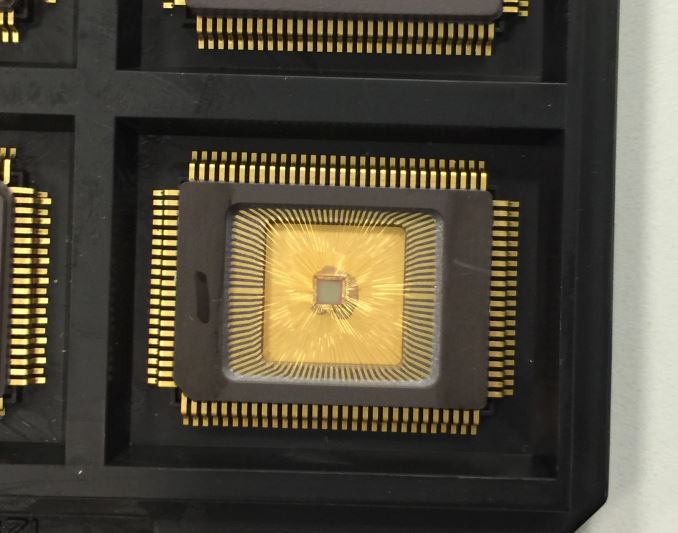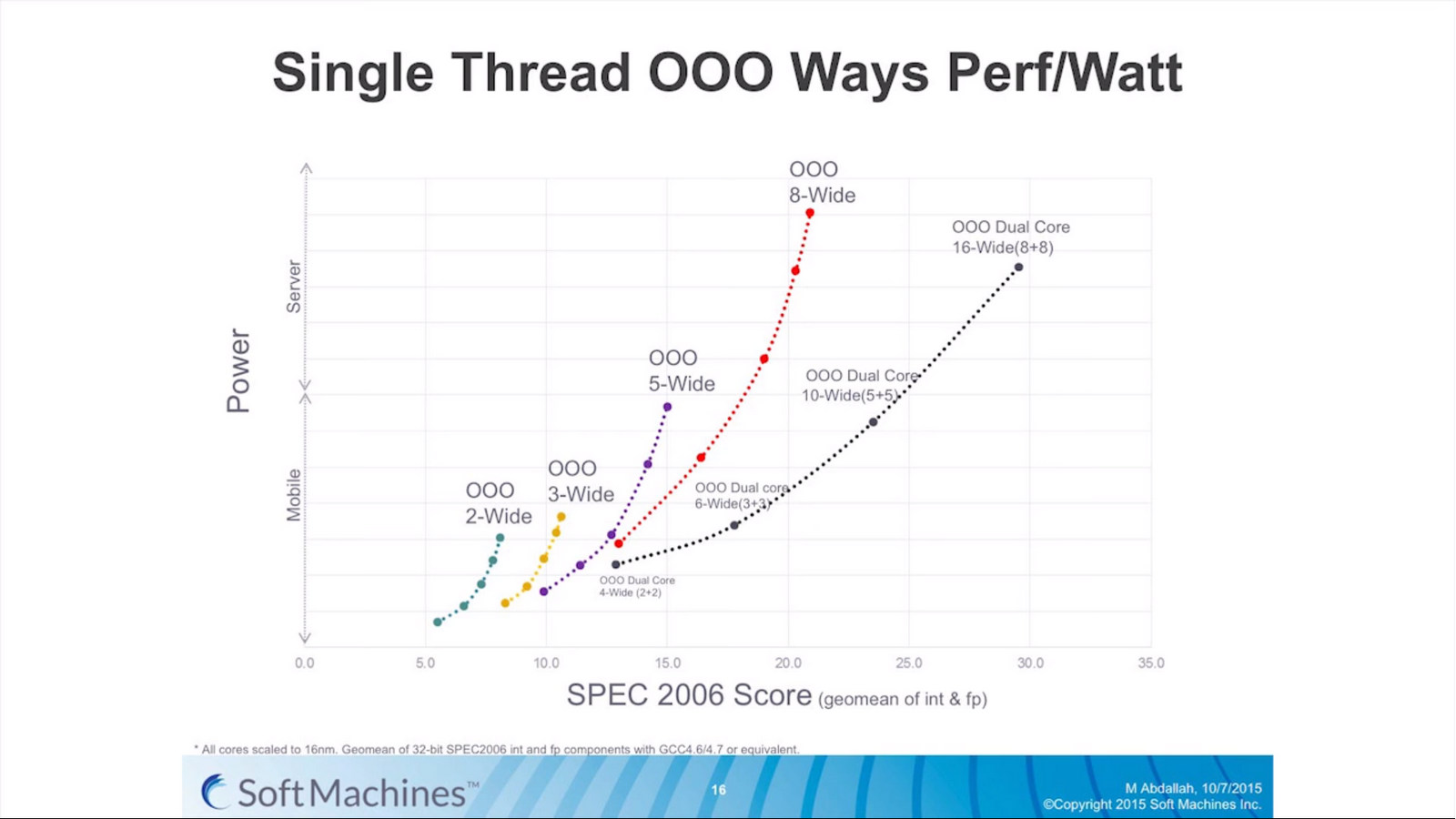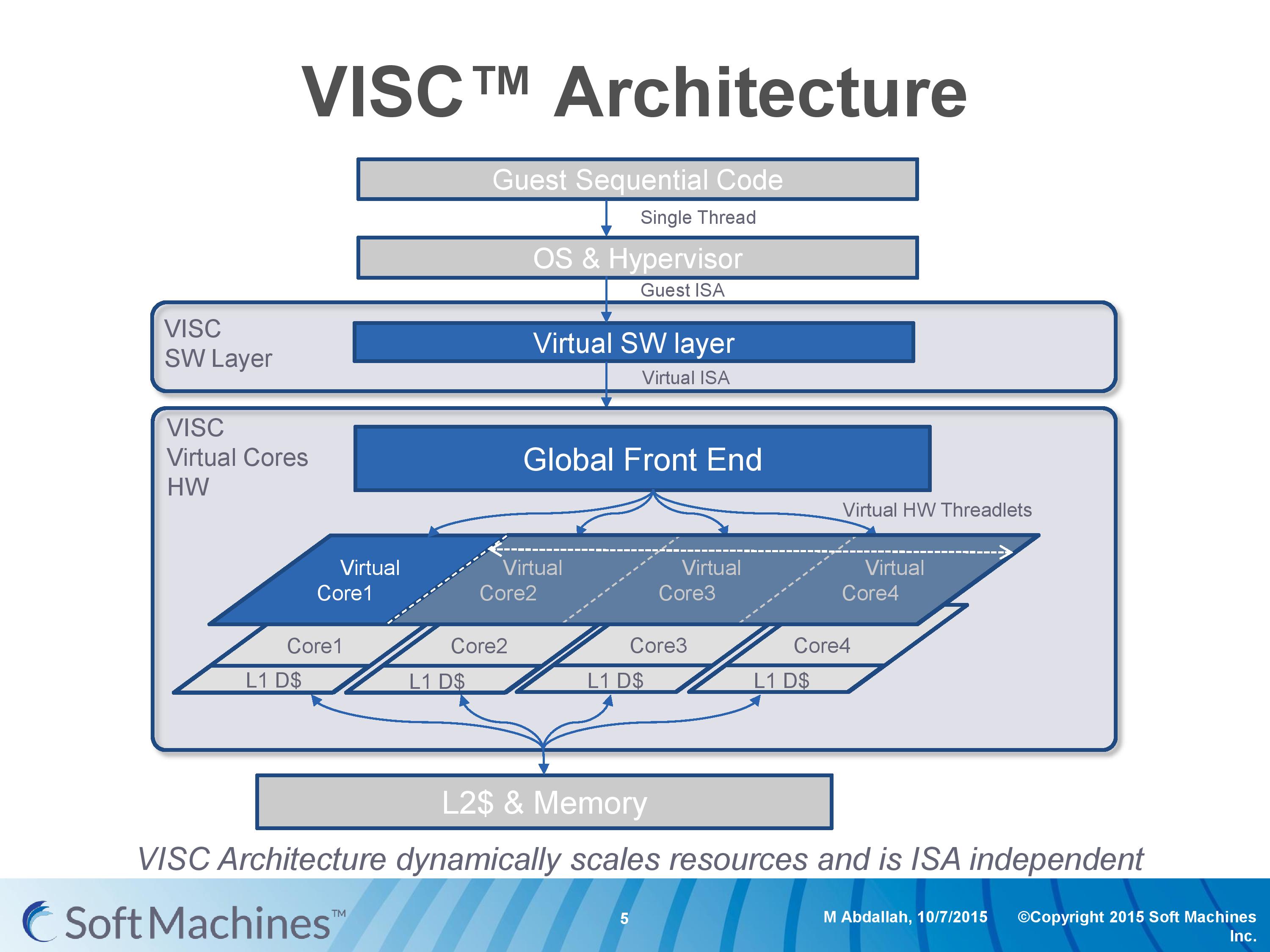Examining Soft Machines' Architecture: An Element of VISC to Improving IPC
by Ian Cutress on February 12, 2016 8:00 AM EST- Posted in
- CPUs
- Arm
- x86
- Architecture
- Soft Machines
- IPC

Last week, Soft Machines announced that their 'VISC' architecture was available for licensing, following the announcement of the original concepts over a year ago. VISC, in a nutshell, is designed as a solution to improving the number of instructions per clock a single thread can process in a given time, which potentially makes it a very interesting design in an era where IPC gains are harder and harder to realize.
The concepts behind their new ‘VISC’ architecture, which splits the workload of a single linear thread across multiple cores, are intriguing and exciting. But as with any new fundamental change in computer processing, subject to a large barrage of questions. We were invited to a presentation and call with the President and Chief Technical Officer Mohammed Abdallah and the VP Marketing and Business Mark Casey, and I put a number of questions on the lips of analysts to them.
Identifying Single Thread Performance Bottlenecks
Any discussion about processor performance over the last couple of decades has involved several factors, including getting better performance through an increased power budget, a higher frequency, extracting instruction level parallelism (ILP), getting better at minimizing delays through better branch prediction, or adding more cores and improving thread level parallelism (TLP). Each of these methods have varying degrees of success at increasing performance – long-time readers will remember the Pentium 4 days of hitting a frequency and power wall which then switched the focus to efficiency. Some tasks, like graphics, are inherently parallel and can take advantage of multiple hundreds or thousands of cores, or the software can be optimized. However, the nature of most software code and instructions is that they are single threaded by nature, and their performance relies on how fast the instructions can be processed within a single thread.
The main way of increasing performance, or in this case the instructions per unit frequency (instructions per clock, or IPC), is to expand the CPU architecture to allow more commands to be processed at once. Moving from a 3-wide out-of-order architecture to a 5-wide out-of-order architecture theoretically allows for a 66% increase in instruction throughput if (and only if) the code is sufficiently dense enough to extract those operations, and the other features in the architecture can ensure all the operations are fed every clock cycle.
The problem with moving to a wider architecture is typically power and design complexity. As shown by various chip designs over the years, the wider the architecture the more silicon has to be set aside for assets like buffers, re-order windows and caching. If there is a silicon budget and enough power headroom, we see designs like the six-wide Intel Skylake cores or the seven wide NVIDIA Denver cores able to extract peak performance when code is written that matches the hardware. However the potential downside of a wide architecture is that it remains inefficient for sets of instructions that only need a 2-wide or a 3-wide architecture. Alternatively, if multiple programs or threads want to use the hardware, then a single core is inaccessible to additional threads while the first thread is still in use (though this can be avoided somewhat by simultaneous multithreading or SMT which will let another thread have access when the first has encountered a stall such as waiting for L1/L2 memory).
As a result, modern designs also include a number of cores to handle the multile thread/multiple program scenario. Generally speaking this works well, especially with high-performance cores, but it becomes a bit of an issue itself when much of the world’s hardware is actually composed of many cores that have poor single threaded performance. Older Core 2 / Conroe systems, basic Bulldozer, or ARM Cortex-A7 designs are (still) widely used and often ship with multiple cores to allow for multiple programs at once. And while they can scale up with additional threads to the number of cores they offer, if any single or lightly-threaded software needs more performance, those extra cores are not used or are only minimally beneficial overall.
This brings us to Soft Machines, whose VISC architecture aims to change this.
Meet VISC
I should start by saying that despite the similarities to other architectural names, VISC is not an acronym. I asked directly and it is merely a noun for the purposes of trademarking. People can interpret it as a ‘virtual instruction set computing’ or something similar, but the company doesn’t apply any acronym to the letters.
But a virtual instruction set is a good description here. For the most part, processor architectures were traditionally built around either CISC (complex) or RISC (reduced) instruction sets and execution models, while more modern designs (e.g. Intel Core) are increasingly a mix, or so-called ‘CRISC’ design. The difference between CISC and RISC boils down to the fact that simpler designs can be more power efficient, but complex designs can do more complicated things in fewer cycles, all the while CRISC essentially meets the two paradigms in the middle in an attempt to gain the benefits of both, though not without inheriting some of the drawbacks as well. VISC, for lack of a better description, is a RISC design using a custom instruction set over a translation layer which allows a single thread of operations to be dispatched over multiple physical cores. The base diagram looks something like this:
Here is an example of a VISC design with four physical cores. The design can handle four ‘virtual cores’ or threads as well, but what makes the VISC design different is that when the virtual core has a thread of instructions, it can use the resources of any physical core. Thus, if each physical core is a 4-wide out-of-order design, if a thread running on a virtual core can utilize the resources of all four cores essentially making a giant 16-wide design, then under VISC can do so.
This should instantly throw up a number of questions on ‘What!? How?! Why?! Power? Frequency? Performance? Efficiency? Complexity?’ and as well as many others in the industry, we had the same questions.












97 Comments
View All Comments
xdrol - Saturday, February 13, 2016 - link
The Cruzoe was (and Denver is) a VLIW design, it needed software translation to run *anything*, telling what pipeline ports to schedule (a hard optimization problem). Here the translation is supposedly just an ARMv8 to internal ISA mapping, scheduling is still done by hardware like with a normal superscalar design.Jtaylor1986 - Friday, February 12, 2016 - link
Excellent article Ian. Thanksjjj - Friday, February 12, 2016 - link
1 more thing.Any clue about thermal management? Can they turn off individual physical cores or they just lower clocks? Being able to do both would be interesting.
matt321 - Friday, February 12, 2016 - link
This would make sense for someone like Apple to buy/invest/license the technology for their own processor development. They could have common cores with translations for both ARM and x86 (for iOS and OS X respectively) with the long-term goal of migrating completely to VISC ISA.extide - Friday, February 12, 2016 - link
This is interesting, because I have thought of doing a processor design somewhat like this for a long time. Remember when BD was coming out, there were rumors of "reverse Hyperthreading" well this is kinda that.I had thought that someone should make a suuuper wide cpu, like 20 or 30 wide, put TONS of execution resources on it, and then put a bunch of hyperthreads. That way a single thread could use all 20-30 execution resources, if possible, or you could have multiple threads sharing all that. Like instead of a quad core, with 2 threads/core have like a super core with 8+ threads, and then maybe a couple of those.
extide - Friday, February 12, 2016 - link
Although, I had always thought that engineers had thought of this already, and that maybe it was a bad idea due to some reason I don't understand, and that's why we haven't ever seen a design like that. Well, this is pretty similar to my idea, except they aren't making a super core, they are allowing a thread to use resources from several cores, if it needs.Exophase - Friday, February 12, 2016 - link
The problem is that going wider decreases efficiency and slows down critical paths. So the processor that's N * 2 wide will have to be a lot slower and/or less efficient than the one that's N wide. If software can rarely extract enough parallelism to go beyond N wide then the N * 2 wide version will almost always be worse. There's a good balance point to be found here.Some components in the CPU even scale worse than linearly as they increase in width. The wiring can increase quadratically or even exponentially.
In practice, a lot of the code that you could realistically extract a ton of ILP from is the type of code that's easiest to vectorize or thread (and a lot of vector + thread friendly can run well on GPUs). What remains, outside of some benchmarks anyway, is mostly a lot of code that has fairly limited ILP due to eventually hitting mispredicted branches or from very long dependency chains. Branch mispredictions are particularly bad on a CPU that has a ton of instructions in flight due to being very wide because that much more energy is wasted on failed speculation.
Oxford Guy - Friday, February 12, 2016 - link
So why wasn't Prescott really great (narrow and deep) versus the G5 (very wide and shallow)?Exophase - Saturday, February 13, 2016 - link
It's like I said, "there's a good balance point to be found here."Faster clocks need higher voltage which scales super-linearly with power consumption. They require longer pipelines which have worse branch misprediction penalties. They take more cycles to talk to other components that don't scale with CPU clock like RAM. More transistors (more space, power) are thrown at these things to try to compensate, like better branch predictors and more reordering, more aggressive prefetching, etc.
So there's a balancing act between two extremes and what makes the most sense will depend on the manufacturing process, target market and various other things.
G5 was actually not very wide and shallow anyway. It was a 2.7GHz processor in 2003 and was supposed to hit 3GHz. It had a 16-21 stage pipeline with up to > 200 instructions in flight. That's not shallow at all. 4 wide decode with 2x ALU + 2x L/S is not really that wide either.
AlexTi - Friday, February 12, 2016 - link
If algorithm is developed which can split current single-threaded code into "threadlets", which can be run in parallel, why can't it be used in compilers to make multi-threaded code to run on existing architecture? Especially in enviroments which use JIT?